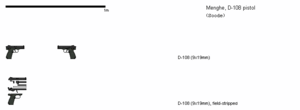D-108: Difference between revisions
No edit summary |
No edit summary |
||
| Line 1: | Line 1: | ||
{{infobox weapon | {{infobox weapon | ||
| name = Type 108 pistol (D-108) | | name = Type 108 pistol (D-108) | ||
Latest revision as of 11:35, 28 March 2019
| Type 108 pistol (D-108) | |
|---|---|
 D-108 with field-stripped diagram (bottom). Note metal frame containing the hammer and trigger group. | |
| Type | Semi-automatic pistol |
| Place of origin | |
| Service history | |
| In service | 2008 to present |
| Used by | |
| Production history | |
| Designer | Samsan Machine Tools Group |
| Designed | 2007 |
| Manufacturer | Samsan |
| Produced | 1994-present |
| Specifications (D-108) | |
| Weight | 720 g |
| Length | 184 mm |
| Barrel length | 104 mm |
| Height | 136 mm |
| Cartridge | 9×19mm |
| Action | short recoil, tilting barrel, double/single |
| Muzzle velocity | 350 m/s |
| Effective firing range | 25 m |
| Feed system | 16-round detachable magazine |
| Sights | Front post, rear notch |
The D-108 (Formal designation: 108식 단총 / 一〇八式短銃, illyŏngpal-sik danchong, "Type 108 pistol;" Short designation 108식, illyŏngpal-sik, "Type 108") is a semi-automatic pistol produced in Menghe. It was developed by the machining section of the Samsan Heavy Industries Group. While significantly lighter than the D-94, it also suffered reliability and problems related to the polymer body, and has not replaced the D-94 in Menghean Army service.
Development
During the mid-2000s, some Menghean Army procurement staff began to express interest in a new service pistol to supplement and eventually replace the D-94. While very popular among servicemen for its ruggedness and reliability, the D-94 was also large and heavy, even compared to the D-70 it replaced.
In response to news that a replacement was under consideration, a machining division of the Samsan Group embarked on a project to develop a new military sidearm, with the goal of securing a lucrative government contract. The design team, hastily cobbled together to meet the deadline, included a few former employees from the established Hwasŏng and Insŏng arsenals, but most of its members were engineers, and few had had recent military experience.
The resulting prototype pistol was completed in 2007 and submitted for testing. As the Menghean Army was then rushing to expand and modernize its forces to meet the threat of war with Maverica, procurement officials expressed interest in the new weapon from the start, accepting it for service the next year as the D-108 and placing a small order.
Design details
The D-108 uses an interesting modular layout, in which all components of the action are attached to a self-contained metal frame that slides free of the body during disassembly. The only moving part attached to the all-polymer handgrip is the reversible magazine release switch. This allows damaged or defective pistols to be easily repaired in the field: the action section can be sent back to an ammunition depot for repairs and replaced to a new one snapped into the body; or a damaged body can be discarded and a spare slipped onto the action section. The polymer grip and shortened barrel and slide also allow for major weight and size reductions compared to the D-94.
In all other respects, the D-108 is functionally similar to the D-94. It uses a short-recoil, tilting-barrel system with a double-action/single-action trigger, and feeds from a 15-round magazine in the grip. The controls are nearly identical between the pistols for easy conversion training.
Assessment
Not long after the first deliveries to combat troops took place, negative reviews from servicemen began to pour in from the field. The main problems related to the polymer lower sections, which were made from sub-par materials and were easily bent or deformed when handled roughly. The frame-enclosed actions also suffered parts failures at higher rates, negating the supposed maintenance benefits of the pistol's modular construction.
As veteran cadres of the Menghean Army strongly valued reliability in sidearms, reports of failures in the field led to a suspension of new D-108 orders in 2011 and a partial recall of already-issued pistols from front-line units. After conducting more grueling tests, the Army confirmed that the D-108 had durability problems and cancelled its outstanding orders, instead switching back to the D-94, which was still in production.
Alarmed at the loss of the contract, the Samsan design team made a number of changes to the pistol, using thicker steel components in the action and selecting a new polymer material for the lower sections. A revised D-108 pistol was submitted to the Army in 2014, but it initially received little attention in light of the scandal surrounding the original version.
In 2016, the Menghean Army relented to the Samsan team's requests and subjected the revised design to endurance tests. It did not perform as well as the D-94, but it did show significant improvement over its earlier version, and met the Army's minimum standards for durability. Eventually, a compromise agreement was reached, in which the Army agreed to issue the D-108 to pilots, truck crews, and some military police units, where it would see less rough use, but continue issuing the D-94 to front-line infantry and armored vehicle crews.
Users
